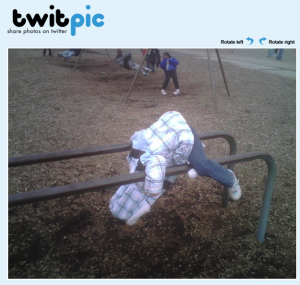This weekend I got another firsthand view of why, despite suggestions that today’s kids will chase after whatever is the next new shiny toy, Facebook will have long-term staying power.
I witnessed scores of young ladies (the young men were much less active in this) taking pictures of each other and their dates at the Austin, Minn. High School Prom. Then two of them who are really close to me came home the next evening and started uploading dozens photos to Facebook, and tagging all of their friends.
So, for example, here is a pre-prom picture that showed up in my news feed, after Bekah tagged me:

And here’s a partial group picture from one of the early Saturday evening events:

Some observers warn that Facebook will become uncool because people like me (or at least in my age group) can be members. Others say the concern is that with Facebook being a “walled garden” in which your data goes in but doesn’t come out, users will rebel because they want data portability.
I don’t buy either of those arguments. Facebook’s variable privacy settings (as described in Facebook 210) mean people of all ages can coexist in the same social networking space, just as we all formerly used the same land-line phone network and now use interoperable digital cell phones with text messaging.
Just because we have the technical ability to interact through cell phones doesn’t mean I’m regularly “texting” people of my daughters’ generation. But it doesn’t stop us from peacefully coexisting in the same digital spectrum. And if I needed to reach one of them in an emergency, being able to send a message through Facebook may be just the ticket.
Likewise, I only know one of their peers who’s using Twitter. This tool of the geeky set has a lot of potential, but hasn’t broken through to mass appeal in anything like the numbers that Facebook has, partly because a lot of people look at it and can’t immediately see what good it will do them. But if they ever discover Twitter, they won’t let the fact that Robert Scoble and I are using it keep them from taking advantage of its wonderfulness.
They don’t have a problem figuring Facebook’s functionality, though, which is why it’s the top photo-sharing site on the Internet. It’s just simple to use, and over their high school and college years they will load lots of memories to these servers.
Unlike the data portability purists, who want the ability to integrate data from all sorts of yet-to-be-invented services into whatever container site they desire, my daughters and their friends just want to be able to connect with each other easily. And they LOVE Facebook Chat. Data portability means nothing to them. Functionality does. They want to be where their friends are, and they don’t particularly care about the identity of Facebook’s other 70 million active users.
As long as Facebook keeps developing and improving its service and doesn’t violate their trust in a way that creeps them out, the likelihood that many of its younger users will bail for another network is remote. And as they see how friend lists can make it reasonably easy to separate personal and professional networks in one site, they’ll be less inclined to join a network like LinkedIn.
I still think LinkedIn is likely to do well in the long term, because it has a critical mass in business networking. But with 14 million photos uploaded to Facebook daily, I see its critical mass continuing to grow as well. People aren’t going to lightly leave a few hundred friends and their photos behind.
What do you think? The growth in Facebook’s reported number of active users seems to be slowing somewhat, but do you see anything on the horizon that would cause it to decline? Any possibility of a recession (two quarters of negative growth) for Facebook?


























